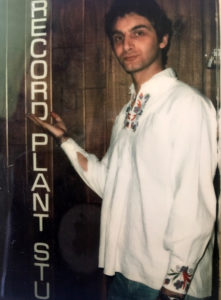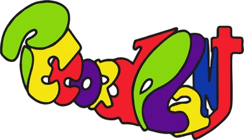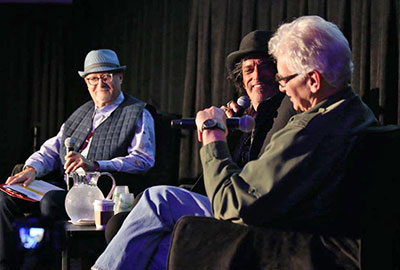Jack Douglas’s mind was blown.

The rock and roll bass player from the Bronx, who just months earlier was cleaning toilets at the hippest studio in New York, was alone behind a $100,000 console getting ready to work with The Who. On the band’s second night of recording at Record Plant New York, Douglas set up the studio microphones, threaded the tape machines, and tested the monitors in surround. Then he waited, and waited, and engineer Jack Adams was nowhere to be found.
Douglas had moved up quickly at Record Plant New York. He started as a janitor, advanced to the tape library and the dubbing room, then cut demos for unknowns like Patti LaBelle and Billy Joel. Just a few days earlier he was called up to assist Adams on The Who’s new concept LP. “Jack Douglas…he had smarts. Caught on right away. When he was around Roy (Cicala), he was all ears,” Lori Burton recalls.
When the band finally arrived ready to work, nobody questioned the fact that the kid who ran out for burgers the night before was now behind the board. And, like any new driver being handed the keys to a Ferrari, Douglas focused his eyes on the controls, tried to remember which buttons and sliders did what, and was determined not to fuck things up; the last time he worked alone, with Patti LaBelle’s new vocal trio, a cup of coffee fell on the console electronics.
The Who was at Record Plant New York to work on new songs for an unfinished rock theater- production called Lifehouse that would never materialize but would evolve into Who’s Next. They were also officially inaugurating the recently upgraded Studio A, an exact, east coast replica of Gary Kellgren and Tom Hidley’s now popular Studio A LA design. Douglas’s boss, Jack Adams, was not particularly fond of The Who’s music. In fact, the studio’s flamboyantly gay chief engineer wasn’t even sure who the band was, according to Douglas: “I had to tell him about Tommy. As far as he was concerned, that music did not have a groove.”
In contrast, Douglas was a big fan of UK-rock and roll. His story-arc in music dated back to 1965 when he and a bandmate hopped a freighter to Liverpool to meet the Beatles. “Immigration wouldn’t let us land because we had guitars and amps, and we had no visas, and no return trip tickets. So, that very first night, I escaped from the ship, and went to central Liverpool where I went into a record store and bought Rubber Soul the week it came out. And, determined to stay in Liverpool, I went to the local newspaper and told them a story about being an American musician and being held captive on a ship.”
Douglas’s story ended up on the front page of the Liverpool Echo, which pressured immigration to let “the Yanks” go free. He hung out at the Cavern Club, played in a band in Liverpool, but was caught performing and eventually got deported, which again caused a local stir and gave him a great tale to tell everyone back in New York.
Working with one of the great British-invasion bands was more than just a brain freeze for Douglas; ever since Eddie Kramer first arrived, the Record Plant had been trying to book the English groups; both Kellgren and Cicala spent time over in London getting to know the bands, their producers, and their engineering techniques. The studio was now battling for attention in a growingly competitive New York music scene, and with Hidley’s new control room design ready to be road tested, The Who’s arrival was a signal to the market that the Record Plant was back on top.
Who producer Kit Lambert had worked at Record Plant New York earlier that year with Patti LaBelle and the Bluebelles and manager Vicki Wickham; he fell in love with the studio’s loud and loose style and its chief engineer with whom he explored the city’s post-Stonewall nightlife. Adams had worked with Hendrix, but he was essentially an R&B engineer whose prominent high-hat sound became his signature on many of the R&B records of the era. And though he hated getting up early in the morning, Adams was also a go-to engineer at the McCann-Erickson ad agency for their popular, R&B series of “It’s the Real Thing” jingles for Coca-Cola. Adams was especially close to Wickham who needed a Green Card to continue working in the United States, so he married her to help keep her in the country.
Like The Who band members themselves, Adams was living on the edge. The drinking, drugging and partying were starting to show and, even worse, affect his work, which explained his disappearances during the Record Plant sessions. As assistant engineer, Jimmy Robinson told a Who biographer: “I used to call him ‘Merlin’ because he would disappear a lot during sessions. He would literally say ‘Jimmy, take the board,’ and then he would disappear. We’d eventually find him in the broom closet or in the bathroom stall with a half-empty bottle of Scotch, the door locked, passed out.”
Jack Adams’s drinking gave Jack Douglas his “star is born” moment during the Who’s Next sessions; like so many of the other assistants under Roy Cicala’s tutelage, he was thrown into the deep end and left to sink or swim. At the time, the Record Plant New York regime was in transition anyway – from Gary Kellgren’s original crew to Roy Cicala’s A&R Studio recruits — and the recording philosophy was changing as well. “These guys coming over from A&R, they were from the (A&R owner) Phil Ramone School of Recording,” Douglas relates. “And that was — you get it to sound exactly like it sounds out in the room, and then you make it sound like a record; you add the magic. Whereas the Kellgren guys were all about feel – ‘How did it feel? Did it feel good?’ — Jack Adams was very much about how something felt; he especially liked to feel the full blast of the quad monitors in the control room.”
When Lambert told Townsend that he had booked two weeks in the same studio that produced Electric Ladyland, working with one of Jimi’s own engineers, the artist was impressed by the provenance; Townsend was dissatisfied with the results he was getting out of his own home studio; as he told Sounds magazine in an early 1971 interview, “When we finished it didn’t sound like The Who at all. It sounded like one of my demos.”
The fine-tuned, control room playbacks reminded the band what a studio album should sound like, though they struggled to play live in the heavily trapped room. At one point, they switched to the original, livelier Hendrix Studio A (now B). It was during those sessions that Douglas rolled in a beat-up, old upright grand piano he found in a tenth-floor storage closet for Townsend to bang on; and Townsend loved the rich, bright and percussive sound; that piano remained in the studio for decades, eventually being dubbed the “John Lennon Piano” due to its use by the Beatle as his go-to studio-songwriting instrument.
The Who wanted to play loud, fast and live. Mountain guitarist Leslie West sat in and jammed with them on the Marvin Gaye tune, “Don’t Break My Heart,” remembering tension between the band and their producer during those dates. As he told a Who biographer: “Kit Lambert was out of his fucking mind. We were doing one of the tracks, and it was going along great. Kit comes out with a sign that says, ‘Great work! Keep it up!’ He’s putting it in front of our faces as we’re playing. Pete stops the session and calls Kit a fucking twit for ruining the take. You know, he’s running around like a madman with a sign in front of everybody while we’re recording. I’d never seen anything like it.”
Lambert was more of a “conductor” than a “producer,” according to Jack Douglas. During Roger Daltrey’s vocal overdubs on “Won’t Get Fooled Again,” he illustrates, “Kit kept changing the intensity and colors of the lights. I saw him throw himself across the console at one point to reach the controls — I mean, he must have got some bruises the way he did it – and just dove to make a lighting change on a song. It was quite amazing to watch. After we finished those sessions, Lambert gave both Jack and me an ounce of cocaine as a present.”
Lambert wasn’t the only member of The Who organization pushing it past 10. “Keith Moon was crazy too,” Douglas adds, “A number of times, I went into the drum booth to change a mic, and he would be sitting there naked.”
The Who worked until midnight, then kept the party going till dawn at either their Navarro Hotel suites or uptown at Jack Adams’s houseboat on the Hudson. Jack Douglas was there after-hours too. “The guys in The Who kind of adopted me,” he remembers. “After I did a couple of their sessions without Jack (Adams), they would take me out after the dates. We would meet at the Navarro Hotel on Central Park South where Keith and Pete had the two, front suites facing Central Park, taking up the entire ninth floor. We’d be sitting in Pete’s suite and Keith would come crawling through the window, which meant that he had crawled out his window on the 9th floor, inched his way along the ledge, and then opened a window to come inside. I was the only one who thought that was weird; I’d be like, ‘Holy shit. That ledge is not that wide.’” At the parties on Jack Adams houseboat, Douglas recalls, Keith Moon would always be center stage. “Keith could do imitations of anyone. He could imitate Kit for example. And he was very smart, and very quick. He was somebody out of the Goon Show. I mean, he was a borderline genius.”
The two-week Record Plant New York booking only lasted three days. On March 16th, The Who laid down “Won’t Get Fooled Again” and the guitar duel between Pete Townsend and Leslie West. On the 17th, they recorded “Pure and Easy” and “Love Ain’t For Keeping.” They wrapped things up the next day with “Getting in Tune” and “Behind Blue Eyes” when, unexpectedly, a falling out between Lambert and Townsend brought the sessions to a halt. Pete overheard his producer dismissing the Lifehouse project as self-indulgent crap, and the comments pushed him over the edge (and nearly out the window of his hotel suite). Townsend abruptly decided to pick up his tapes and return to London where he fired Lambert and replaced him with Rolling Stones and Led Zeppelin-producer Glyn Johns who loved the material but discarded the Record Plant Who’s Next recordings. Those tapes were eventually thrown into an Olympic Studios dumpster as part of a studio house cleaning, only to be retrieved by a bootlegger who released them as the album From Lifehouse to Leeds. Ultimately, the Record Plant’s biggest contribution to The Who catalog was as the first-time Townsend experienced Tom Hidley’s quadraphonic sound effect that would inspire the title of his next rock opera, Quadrophenia.
While the Who’s Next sessions were a career breakthrough for Jack Douglas, they marked the beginning of the end for Jack Adams in New York. His drinking was getting in the way and young up-and-comers like Jack Douglas could less-expensively fill the void. Kellgren and partner Chris Stone were eager to hire him to move out to LA anyway, where Adams could help with the growing number of R&B dates. And, uncharacteristically, Cicala agreed to let LA poach one of his New York engineers.
Stone and Cicala rarely agreed on anything. Stone was used to working with Kellgren who he could easily mold, while Cicala was stubbornly convinced that he didn’t need a “studio civilian” sitting in the side office telling him what to do. Cicala believed he owned the Record Plant long before he owned it; if he wanted to extend credit, dip into petty cash, buy gear or protect an individual engineer, it was his decision to make.
“I know all you care about now is LA, which makes you a competitor. You take west, I’ll take east, and we don’t cross each other’s business,” Cicala warned Stone.
“I didn’t know it was your business.”
“Maybe someday, if Kellgren keeps his hands off the east coast talent.”
Cicala was still pissed off at Kellgren for having tried to poach Tom Flye for Sly Stone out in LA, and specifically told Stone that Flye was off limits. Another Jack Adams protégé, Flye was known for his patience, knack with a blade, and ability to work 14-hours straight through the night and still leave the studio spanking clean for the ad agency clients when they arrived the next morning. Stone and Kellgren already had plans for Flye, but it was too early to make a move. So, when Cicala told Stone that Flye had an important, upcoming date with a singer/songwriter with an 8-minute single to record, Stone agreed to back off.
Good thing. Without Flye in New York that spring there would have been no “American Pie.”






